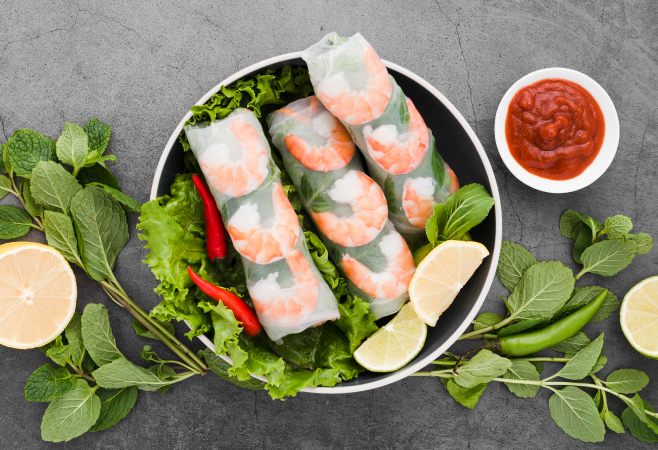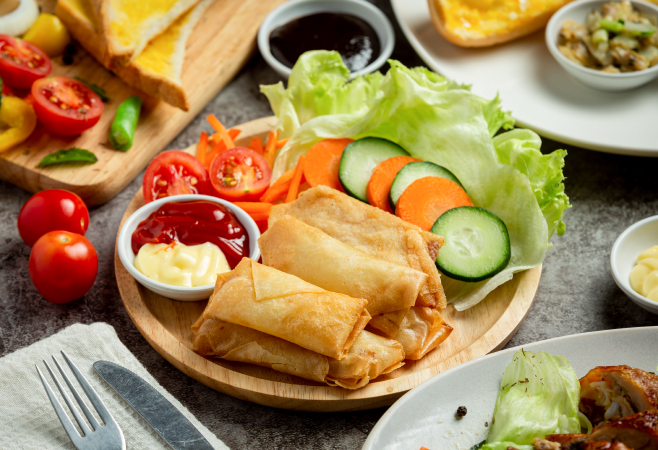Vietnamese Spring Rolls: A Culinary Emblem of Freshness and Flavor
Vietnamese cuisine is renowned for its diversity, fresh ingredients, and vibrant flavors that tantalize taste buds around the world. Among the numerous delectable dishes that showcase the rich culinary heritage of Vietnam, the Vietnamese spring rolls stand out as a delightful and iconic dish. These rolls, known as "Gỏi cuốn" in Vietnamese, are not just a dish; they are a cultural emblem, embodying the essence of Vietnamese cuisine.
The Origins and Evolution of Vietnamese Spring Rolls
The history of Vietnamese spring rolls traces back centuries, evolving through cultural exchanges and regional influences. These rolls are believed to have originated in northern Vietnam, eventually spreading throughout the country and beyond. Initially, they were a dish reserved for royalty and aristocrats due to the intricate preparation and exotic ingredients involved.
Traditionally, Vietnamese spring rolls consist of rice paper filled with a combination of fresh vegetables, herbs, rice vermicelli, and often include proteins like shrimp, pork, or tofu. These ingredients, chosen for their freshness and flavors, symbolize the harmony of textures and tastes that define Vietnamese cuisine.
Apart from their delectable taste, Vietnamese spring rolls boost nutritional benefits. Packed with fresh vegetables, lean protein, and minimal oil, they offer a wholesome and balanced meal. The abundance of herbs and vegetables provides vitamins, antioxidants, and dietary fiber, contributing to a healthy diet.
Do not ignore an astonishing assortment of flavors, textures, and scents of Vietnamese street food through Discovering The Vibrant Flavors Of Vietnamese Street Food Scene.

Vietnamese Spring Rolls are a healthy food
Vietnamese Spring Rolls Recipe That Creates Magic
How to make Vietnamese Spring Rolls
The beauty of Vietnamese spring rolls lies in their simplicity and the quality of the ingredients. The key components include:
1. Rice Paper:
Rice paper serves as the foundation of the spring roll. Made from rice flour, water, and salt, it's translucent and pliable when soaked in water, perfect for wrapping the ingredients.
2. Fresh Vegetables and Herbs:
Crunchy lettuce, crisp bean sprouts, aromatic cilantro, refreshing mint leaves, and basil contribute to flavors and textures in each bite.
3. Rice Vermicelli:
Thin rice vermicelli noodles, pre-soaked and drained, add a soft and chewy element, balancing the crunch of the vegetables.
4. Proteins:
Cooked shrimp, tender slices of pork, or marinated tofu provide a protein-rich component, adding depth to the rolls.
5. Shrimp:
Medium-sized shrimp are ideal for spring rolls. I prefer preparing the shrimp with their shells intact as it enhances their vibrant color after cooking. The most convenient method to cook these shrimp is by boiling them for a brief two minutes.
6. Vietnamese Spring Rolls sauce:
The dipping sauce, a crucial accompaniment, often comprises a blend of hoisin sauce, peanut butter, garlic, chili, and lime, creating a harmonious balance of sweet, salty, and spicy flavors.

The ingredients of spring rolls Vietnamese are easy to prepare
The Art of Assembly
Making Vietnamese spring rolls is an art form that requires meticulous preparation and skillful assembly. The assembly process involves soaking the rice paper in warm water briefly until it softens, then laying it flat on a clean surface. Next comes the arrangement of the fillings—vegetables, herbs, noodles, and protein—neatly on the lower third of the rice paper. The sides are folded inwards, followed by a tight rolling motion to encase the fillings securely. The result is a translucent roll showcasing the vibrant colors of its contents.
Tips
-
Ensure not to overfill the rolls to make them easier to roll and prevent tearing.
-
Store any unused rice paper sheets in a sealed bag to prevent them from drying out.
-
Customize the fillings to suit your taste preferences or dietary needs, making vegetarian or vegan variations by excluding meat or seafood.
-
Preheat oil in a pan or deep fryer for fried spring rolls and fry the assembled rolls until golden brown and crispy.
With this simple yet intricate recipe, you'll create delectable Vietnamese spring rolls that encapsulate the essence of freshness and cultural heritage. Whether as an appetizer or a full meal, these rolls will surely delight and transport your taste buds on a flavorful journey through Vietnam's culinary treasures.
Another type of Vietnamese Spring Rolls
Vietnamese spring rolls fried, known as "Chả giò" or "Nem rán," present a delightful departure from the traditional fresh rolls. These golden-crusted rolls boast a satisfying crunch that envelops a medley of minced pork or shrimp, glass noodles, and a flavorful mix of shredded carrots, cabbage, wood ear mushrooms, shallots, and garlic. Seasoned with fish sauce and a hint of sugar, the filling is carefully encased in a delicate rice paper wrapper before being fried to crisp perfection.
With each bite, the crackling exterior gives way to a savory amalgamation of textures and tastes, making fried Vietnamese spring rolls an irresistible treat.

The fried Vietnamese spring rolls
How Vietnamese Spring Rolls Spread over The World
Beyond being a culinary delight, Vietnamese spring rolls hold cultural significance in Vietnamese traditions. They are often featured in celebratory occasions such as Lunar New Year (Tết) and family gatherings, symbolizing luck, prosperity, and togetherness. The communal aspect of assembling spring rolls brings families and friends together, fostering a sense of unity and shared experience.
The popularity of Vietnamese spring rolls has transcended borders, becoming a beloved dish worldwide. Restaurants across the globe offer their interpretations, adapting the traditional recipe to suit local tastes. Some variations include vegetarian rolls, fruit-infused rolls, and even dessert rolls filled with sweet ingredients like mango and chocolate.
Conclusion
Vietnamese spring rolls are more than just a culinary creation—they embody a cultural heritage, and a culinary art form passed down through generations. More than just a dish, Vietnamese spring rolls represent a communal experience, bringing together families and friends to share in the art of assembly and the joy of savoring each bite. Their versatility allows for endless variations, catering to diverse tastes and preferences while maintaining the essence of freshness and balance.
Whether enjoyed as a light and refreshing appetizer or as a crispy and indulgent treat, Vietnamese spring rolls offer not just a feast for the palate but a cultural journey, inviting all to partake in the exquisite flavors and traditions of Vietnam. Their simplicity in preparation belies the complexity of tastes they offer, making them a beloved and timeless dish cherished by many across the globe.
Related Articles
- Custom In Vietnam: A deep dive into Vietnamese traditions
- Retire in Vietnam: The ultimate guide for a dream retirement
- Trang An, Vietnam: A journey through Vietnam's natural wonder
- Vietnam Metro: The future of urban transportation in Vietnam
- Main districts of Ho Chi Minh city: Iconic landmarks & travel map
HOW CAN WE HELP?
APPLY WITH CONFIDENCE










